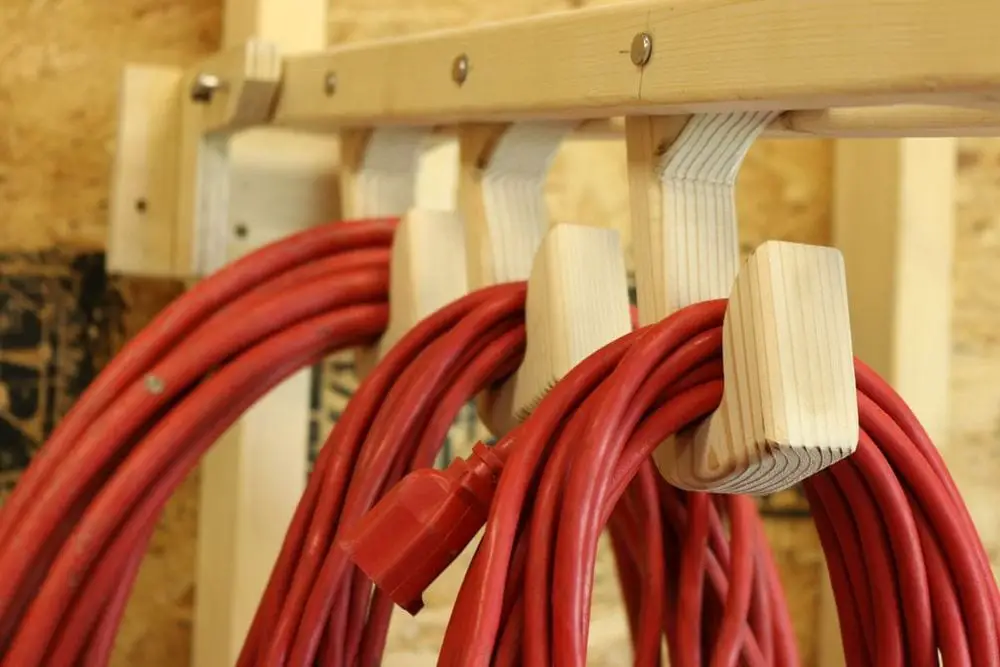
Items with cords or wires often end up tangled no matter how neatly we arrange them. They seem to magically turn into a tangled mess. Admit it, it can be a hassle, especially if you need to use them right away.
Good thing there are now cable holders for our phone chargers and earphones. However, there are bigger cords that need to be organized – extension cords, for example. We’ve had several instances of having someone trip over an extension cord because it was all over the floor.
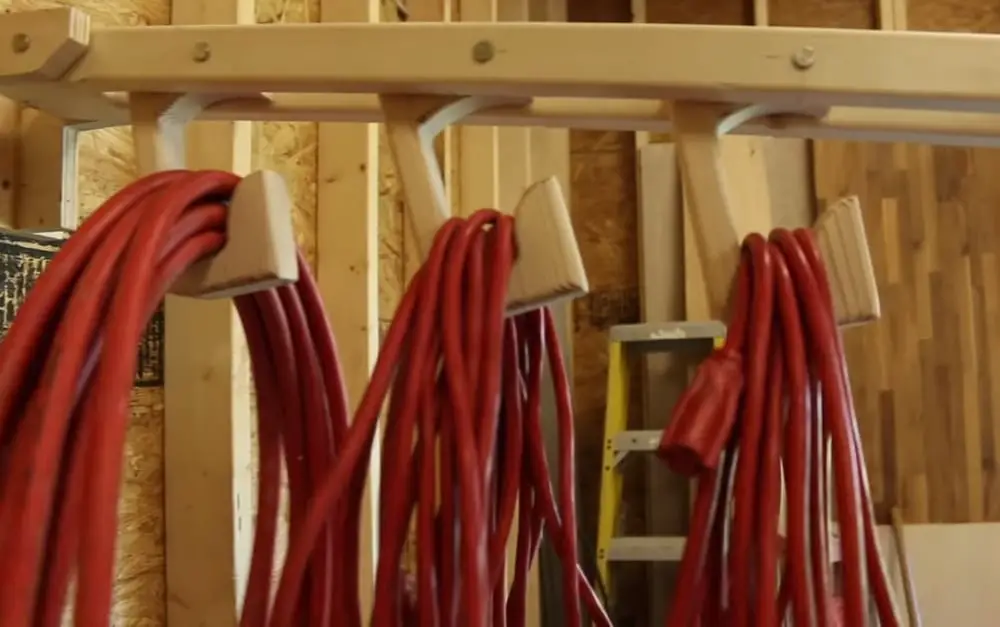
We knew we had to make one when we came across a DIY project for a folding DIY cord organizer. My husband worked on it one weekend and he finished it in one day. After seeing the finished product and actually using it, I have started to classify it as a necessity.
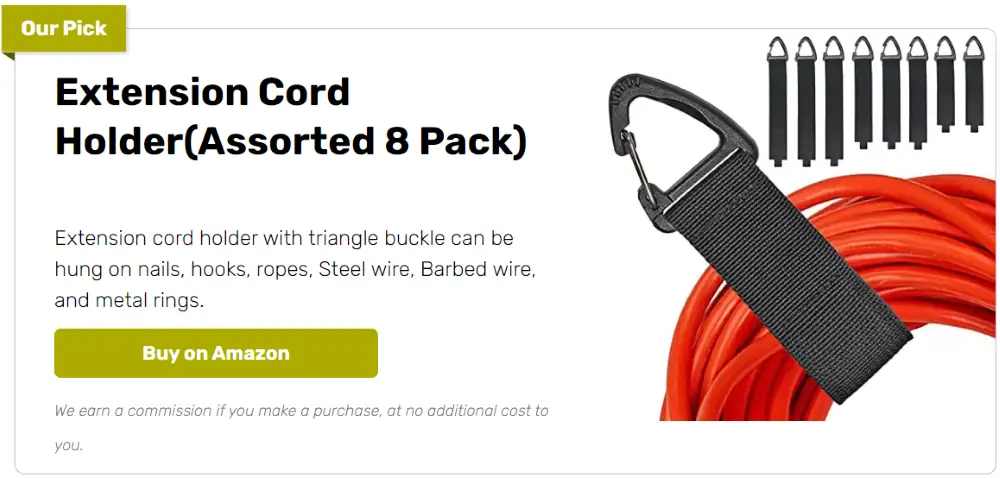
In case you don’t know it yet, I’m telling you now: you need this at home. It’s a simple project but the benefits are great. Thank me later. Below is how to organize extension cords at home!
Contents
Building an DIY Cord Organizer
Materials:
- Wood
- Door hinges
- Hinge pin
- Steel rod
- Screw
Tools:
- Drill
- Circular saw
- Jig saw
- Router table
Instructions
Step 1: Cut the Wood
Using the circular saw, cut the wood into panels for the sides, top, and bottom of your organizer. The size can vary based on your needs, but a standard size could be 24 inches long, 12 inches wide, and 12 inches high.
Step 2: Create Slots for Cords
Cut slots along the organizer’s top panel With the jig saw. These slots will be where you insert the extension cords. Space them evenly to accommodate different cord sizes.
Step 3: Drill Holes for the Steel Rod
Measure and mark spots on the side panels for the steel rod. This rod will act as a spindle for wrapping your cords. Use the drill to make holes big enough for the steel rod to fit through snugly.
Step 4: Assemble the Box
Use screws to assemble the wood panels into a box shape. The bottom panel should be attached first to the side panels, followed by the top panel with the slots.
Step 5: Install the Door Hinges
Attach the door hinges to one side of the box. These will allow you to open the organizer easily for access. Make sure the hinges are aligned properly before screwing them into place.
Step 6: Insert the Steel Rod
Slide the steel rod through the holes you drilled in the side panels. This rod will be where you wrap and organize your extension cords.
Step 7: Create a Handle
With the leftover wood, cut a small piece to serve as a handle. Use the router table to smooth the edges for a comfortable grip. Attach this handle to the top of your organizer using screws.
Step 8: Add the Hinge Pin
The hinge pin will be used to secure the door of your organizer. Insert the hinge pin into the door hinges, ensuring the door opens and closes smoothly.
Step 9: Finish and Customize
Sand the entire organizer to smooth out rough edges. You can also paint or stain the wood to match your preferences. Finally, coil your extension cords and place them onto the steel rod, organizing them through the slots on the top panel.
Different Types of Extension Cord Organizers
Extension cords are essential in our homes, offices, and workshops. They give us the flexibility to bring power to where we need it. But managing them can be a challenge. Without proper care, they can become a tangled mess, a tripping hazard, or even a fire risk. An extension cord organizer is the perfect solution to keep your cords neat and safe. Here are different types of extension cord organizers that can help you keep your space tidy.
Wall-Mounted Organizers
Wall-mounted organizers are great for saving floor space. They attach to the wall and allow you to hang your cords off the ground. This type is perfect for garages, workshops, and behind entertainment centers. They come in various designs, from simple hooks to shelves with built-in cord wraps.
Reel Systems
Reel systems are ideal for long extension cords. They let you wind and unwind your cord with ease, preventing tangles and kinks. Some reel systems come with a handle for easy carrying and storage. They’re perfect for outdoor use, like gardening or powering outdoor events.
Box Organizers
Box organizers keep your extension cords hidden and dust-free. These boxes often have slots for the cord ends, allowing you to use the cord while it’s still neatly stored. They’re great for indoor areas where you want to keep things looking tidy, such as offices or living rooms.
Magnetic Organizers
Magnetic organizers use strong magnets to hold your cords in place. They’re versatile and can be attached to any metal surface. This type of organizer is ideal for quickly storing and accessing cords in workshops or kitchens.
DIY Organizers
DIY organizers can be made from materials you have around the house. From simple cardboard tubes to custom wood creations, the possibilities are endless. DIY organizers allow you to customize the size and style to fit your specific needs.
Each type of extension cord organizer offers unique benefits. Whether you’re looking for something to handle heavy-duty outdoor cords or a simple solution for your home office, there’s an organizer out there for you. Keep your spaces safe and clutter-free by choosing the right extension cord organizer for your needs.
Click on any image to start lightbox display. Use your Esc key to close the lightbox.

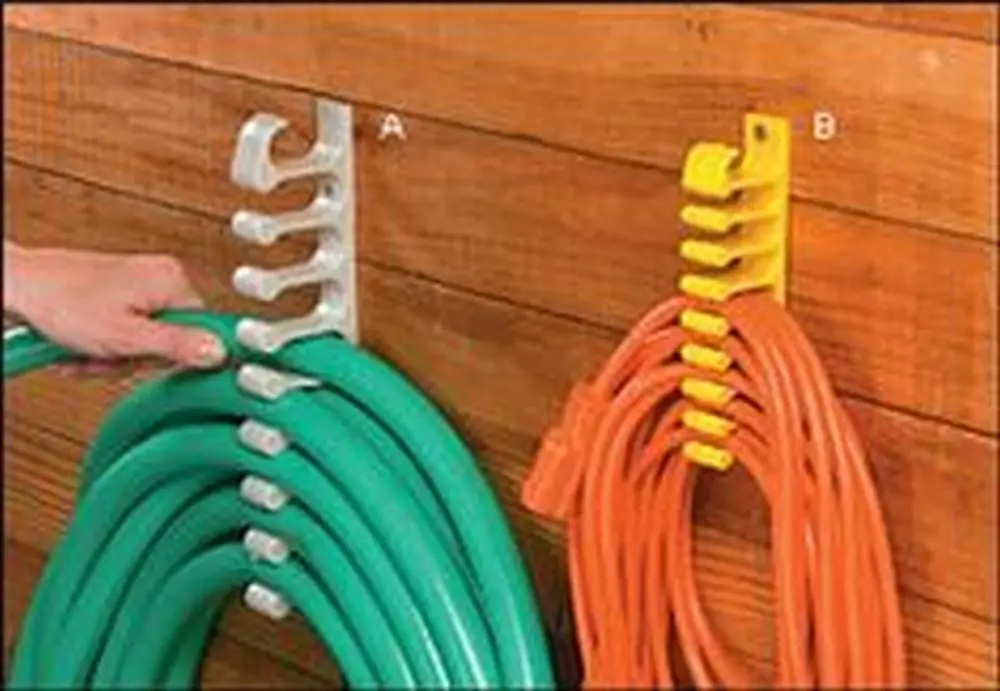
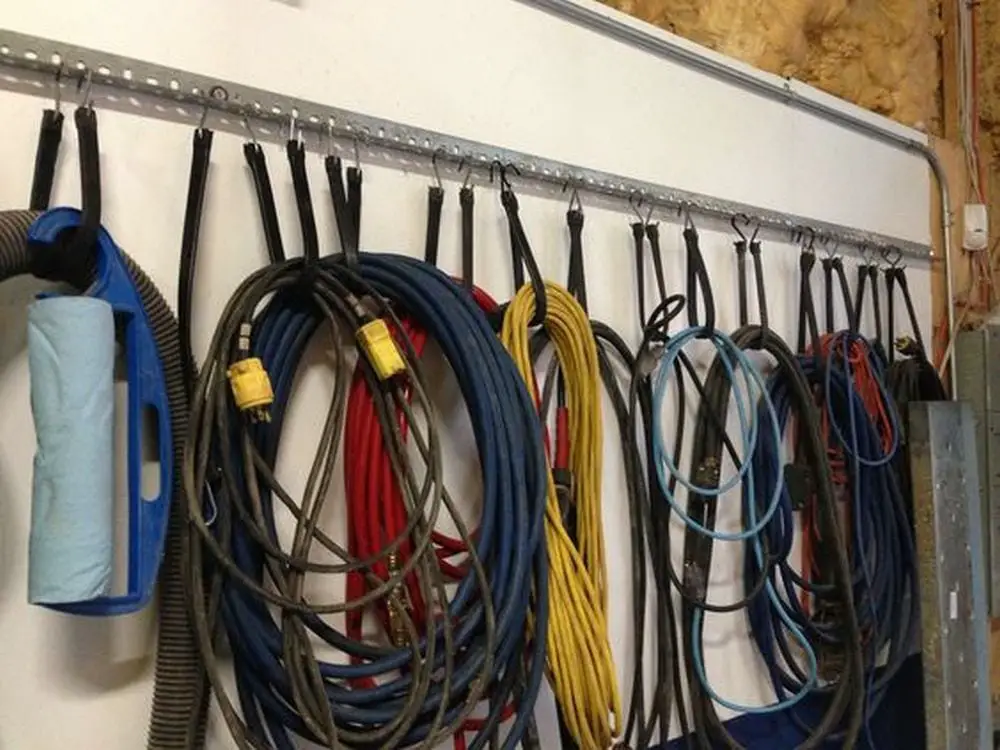
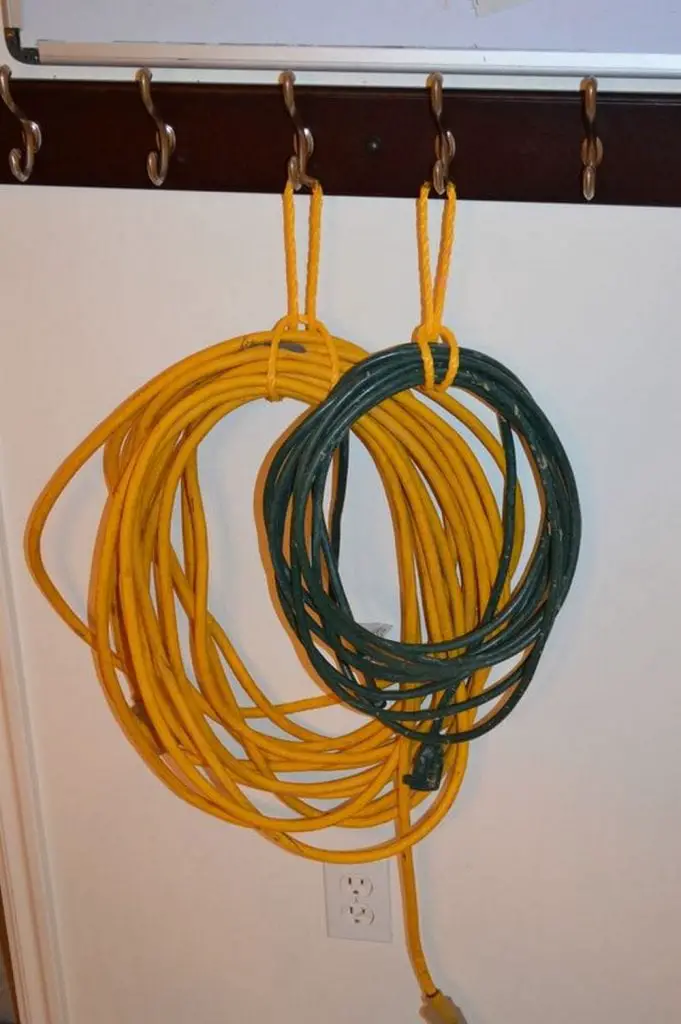
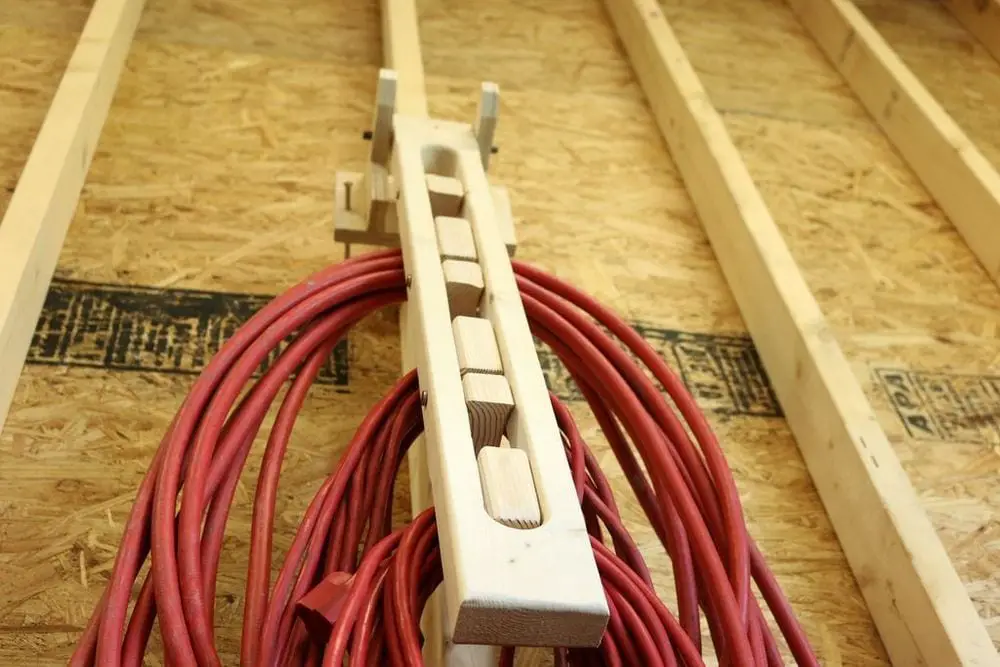

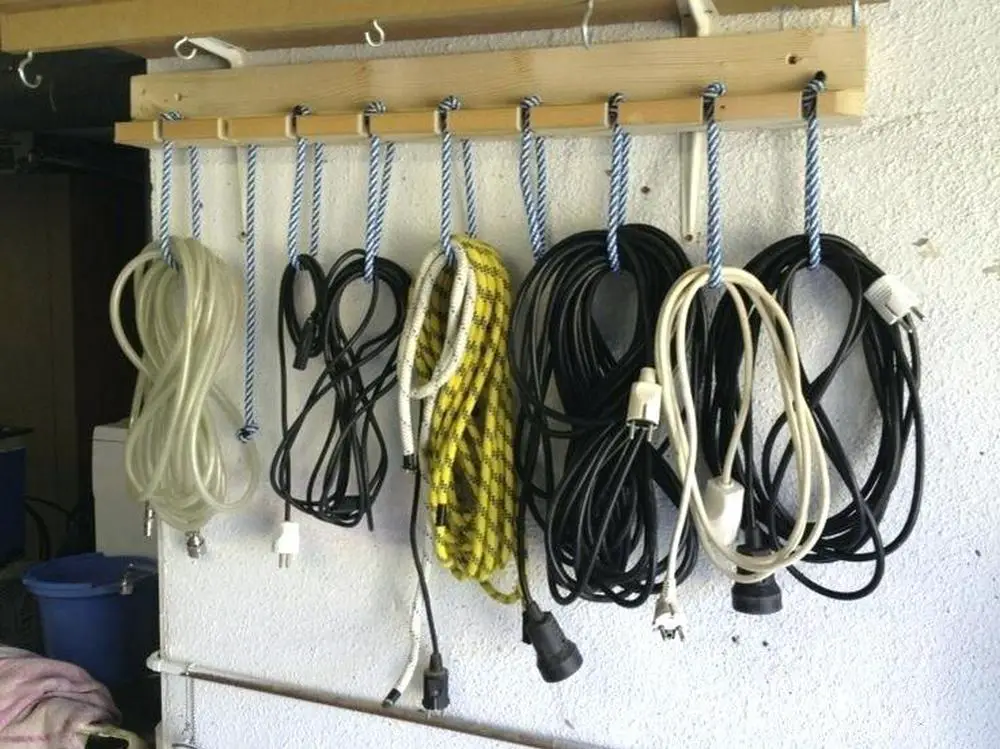
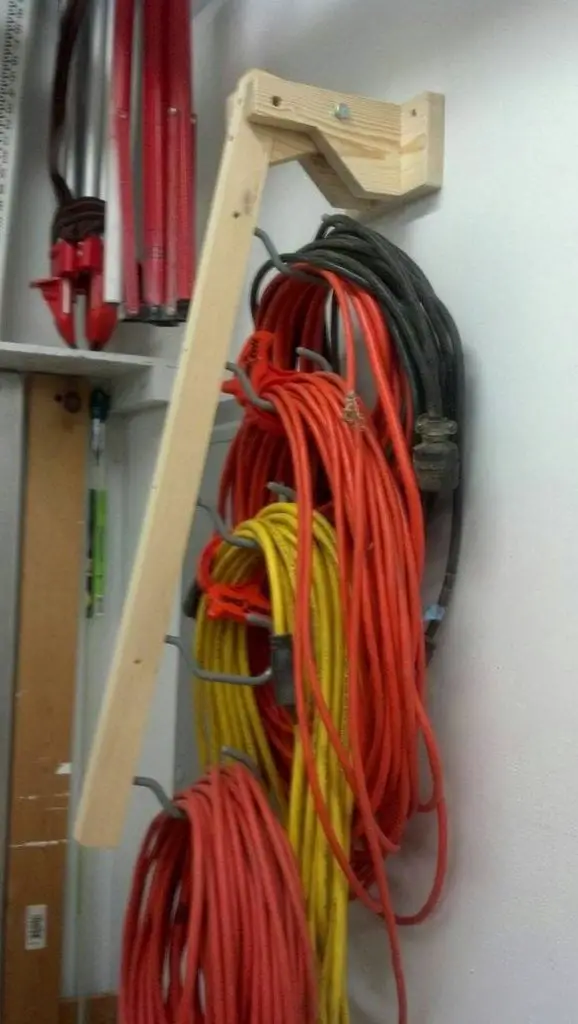
Safety Tips for Using Extension Cords
Using extension cords safely is crucial to prevent hazards in any environment. However, managing these cords effectively is just as important to ensure they remain in good condition and don’t pose a risk. An extension cord organizer can play a significant role in maintaining safety and order. Here are key safety tips that involve the use of an extension cord organizer to keep your spaces safe and clutter-free.
Choose the Right Extension Cord Organizer
Selecting the right extension cord organizer is essential. Ensure it suits the type and size of cords you’re using. For heavier outdoor extension cords, consider a sturdy reel system. For indoor use, a wall-mounted organizer can keep cords off the floor and reduce tripping hazards.
Inspect Cords Before Organizing
Before wrapping your cords into an extension cord organizer, inspect them for damage. Look for frayed wires, cracks, or signs of wear. Damaged cords should be repaired or replaced to prevent electrical fires or shocks. Regular inspection ensures that only safe cords are stored and used.
Avoid Overloading Your Organizer
Avoid overloading it with too many cords when using an extension cord organizer. This stresses the organizer and can lead to tangled cords, making them harder to unwind and use safely. Ensure there’s enough space for each cord to be stored neatly.
Use Extension Cord Organizers to Prevent Overheating
Extension cord organizers can help prevent overheating by storing cords loosely coiled, allowing air to circulate around them. Never cover coiled cords with materials that can insulate heat, such as rugs or blankets. This practice is crucial in preventing fire hazards.
Keep Organizers Away from Water
Water poses a significant risk to electrical safety. Use an extension cord organizer to keep cords elevated and away from potential water sources. This is especially important for outdoor organizers, which should be waterproof and designed to prevent moisture accumulation.
Unplug and Store Cords When Not in Use
An extension cord organizer isn’t just for organization—it’s also a safety tool. Unplug extension cords when they’re not in use and store them in your organizer. This reduces the risk of accidental shock and protects the cords from damage.
Properly storing your extension cords using an extension cord organizer is not just about tidiness; it’s a critical safety practice. By following these tips, you can ensure your cords are always ready for use, without posing a risk to you or your surroundings.
Creative Storage Solutions for Small Spaces
In small spaces, finding innovative and effective storage solutions is key to maintaining an organized and clutter-free environment. An extension cord organizer can be crucial, especially when managing and storing cords and cables that can easily become tangled and take up unnecessary space.
Here are some creative storage solutions that incorporate an extension cord organizer, designed to maximize efficiency in limited spaces.
Use Vertical Space
Using vertical space effectively transforms how we store and organize items, especially in smaller areas with limited floor space.
Focusing on the walls and ceilings allows us to create efficient storage solutions that keep essentials within reach without cluttering valuable living or working areas. Here’s how to expand on this concept, specifically for managing extension cords with organizers.
Installing shelving units on walls offers a versatile solution for storing extension cords and other tools. You can dedicate a shelf solely to an extension cord organizer, ensuring cords are neatly coiled and ready for use. This method not only saves space but also keeps cords from becoming tangled.
Adding hooks beneath shelves or directly on walls provides an easy way to hang extension cords. This approach is particularly effective for shorter frequently used cords, allowing for quick access and straightforward organization.
Pegboards offer unparalleled customization in wall storage. You can use hooks and baskets to create a flexible storage system for extension cords and accessories by attaching a pegboard to your wall. This setup allows you to adjust the spacing and arrangement as your storage needs change, making it an ideal solution for dynamic workspaces.
Ceiling-mounted holders present an innovative way to store extension cords out of the way. By securing these holders to the ceiling, you can loop extension cords over them, keeping them off the floor and preventing tripping hazards. This solution is especially useful in garages, workshops, or studios where maximizing floor space is crucial.
In addition to traditional holders, you can use mounted reels to pull down the extension cord when needed and retract it for storage. This system keeps cords organized and protects them from wear and tear.
Utilizing vertical space for extension cord storage has several benefits. It significantly reduces clutter, making your space more organized and visually appealing. This approach also prolongs the life of your extension cords by preventing them from being stepped on or crushed by heavy objects. Moreover, it makes finding the right cord for the job easier, saving time and frustration.
Under-Furniture Storage
The space beneath furniture is often underutilized in homes and offices. You can tap into this hidden storage potential by introducing slide-in organizers designed for extension cords.
These low-profile organizers are designed to fit snugly under sofas, beds, or cabinets, making them an ideal solution for keeping extension cords organized and out of view. This approach declutters your space and keeps cords easily accessible when needed.
Creating a custom slide-in organizer allows for personalization to fit your furniture’s specific dimensions and aesthetic. Alternatively, purchasing a pre-made organizer can offer convenience and immediate use. Whichever route you choose, the key is to select durable materials and designs that complement your interior décor. By doing so, you maintain the visual appeal of your space while enhancing its functionality.
The benefits of under-furniture storage extend beyond aesthetics. This solution minimizes tripping hazards and protects cords from damage, ensuring they remain in good condition over time. Furthermore, it makes cleaning around and under furniture easier, as cords are neatly contained rather than scattered on the floor.
Multi-Purpose Furniture
Furniture that serves dual purposes can significantly enhance the functionality of any space, especially where square footage is at a premium.
Ottomans, benches, and coffee tables that double as storage units offer a stylish way to reduce clutter and organize essentials, including extension cords. Furniture with a dedicated compartment for an extension cord organizer integrates practical storage solutions seamlessly into your living environment.
Custom-built furniture with storage options can be tailored to meet specific needs and preferences, incorporating an extension cord organizer in a way that is both functional and aesthetically pleasing. This customization allows for innovative design solutions, such as hidden drawers or compartments that can be accessed without disrupting the furniture’s primary use.
Investing in multi-purpose furniture optimizes your living space and contributes to a cleaner, more organized home. It encourages efficient use of space and provides a convenient way to store extension cords, keeping them untangled, undamaged, and ready for use. Moreover, it adds a touch of elegance to your decor, proving that practical storage solutions can also be stylish.
Behind-the-Door Solutions
The back of a door presents a unique opportunity for storage that is often overlooked. Over-the-door organizers tailored for extension cords can transform this space into a highly efficient storage area.
These organizers can hang securely over any door, offering a convenient spot to store and organize extension cords in a manner that is both accessible and out of the direct line of sight. This method is particularly useful in areas where space is at a premium, such as small offices, apartments, or workshops.
Over-the-door organizers come in various designs, from simple hooks and pouches to more elaborate systems with adjustable holders for multiple cords. This versatility ensures that you can find a solution that fits your needs, whether you’re looking to store a few light-duty extension cords or organize bulkier power cables. Moreover, this storage option keeps cords off the floor, reducing clutter and minimizing tripping hazards.
The discreet nature of behind-the-door storage allows for a cleaner, more organized space without sacrificing accessibility. Cords stored in this manner are easy to retrieve when needed, yet remain out of sight when the door is open, contributing to a neater appearance overall.
Modular Storage Systems
Modular shelving units offer unparalleled flexibility in storage solutions, making them an ideal choice for organizing extension cords among other items.
These systems allow for the customization of shelving layouts to accommodate different sizes and types of items, including extension cords, tools, and electronic devices. The ability to adjust shelf heights and positions means that you can create the perfect storage configuration for your needs, even as those needs change over time.
Extension cord organizers into modular shelving units ensures that cords are kept tidy and tangle-free. This can be particularly beneficial in spaces like home offices or entertainment areas, where various electronic devices are used, and cords can easily become a jumbled mess. By dedicating specific shelves or sections to cord storage, you can maintain high organization and efficiency.
Modular storage systems also allow for growth. As your collection of extension cords or other items expands, you can add more modules or adjust the existing setup to accommodate the new additions. This adaptability makes modular shelving and an DIY cord organizer a long-term storage solutions that can evolve with your changing needs.
Drawer Dividers
Implementing drawer dividers within existing furniture is a smart and efficient way to manage extension cords, ensuring they are organized, easily accessible, and tangle-free. Along with an extension cord organizer, this method involves segmenting drawers into smaller, dedicated compartments using dividers, allowing each extension cord to have its own space. Such an organization prevents cords from getting tangled with each other or with other items stored in the same drawer, making it easier to find and retrieve the cord you need without hassle.
To maximize the effectiveness of this solution, you can customize the size and shape of the dividers based on the types and lengths of extension cords you’re organizing. This customization ensures that each cord fits snugly in its designated spot, reducing the risk of tangles and damage. Additionally, labeling each compartment can enhance organization, allowing for quick identification of the specific cords or chargers stored within.
Using drawer dividers for DIY cord organizers helps maintain an orderly storage system and utilizes the often-underused space within drawers. This method is particularly beneficial in office settings, workshops, or entertainment areas where a variety of cords are frequently used and need to be kept organized and within reach.
Hidden Panels
Creating secret storage spots for DIY cord organizers by installing panels or artwork on hinges introduces a blend of functionality and aesthetics to any space.
This innovative storage solution involves concealing extension cord organizers behind movable panels or framed artworks that can be easily accessed when needed. When closed, these hidden panels offer a seamless look that integrates with the room’s decor, effectively hiding the cords out of sight while keeping them organized and accessible.
This approach not only saves valuable space but also adds an element of surprise and creativity to your storage solutions. It’s ideal for living rooms, bedrooms, or offices where maintaining a clean and uncluttered aesthetic is important. The hidden panels can be designed to match the surrounding decor, ensuring that the storage solution does not detract from the room’s overall design.
By implementing these creative storage solutions for small spaces, you can effectively organize extension cords and other items, making the most of every inch of your living or working area. An extension cord organizer is an invaluable tool in achieving a tidy, functional space, no matter the size.
Conclusion
Organizing extension cords is crucial for maintaining a tidy, safe, and efficient space. With innovative solutions like under-furniture storage, multi-purpose furniture, over-the-door organizers, modular shelving, drawer dividers, and hidden panels, there are numerous ways to keep cords neatly stored and easily accessible.
For more ways to organize your space, check out our DIY hat rack project next!
FAQ: DIY Cord Organizer
- How do you create a DIY cable management box for chargers?
- Creating a DIY cable management box is an easy way to declutter your charging area. Start with a small, sturdy box like a shoebox and drill or cut holes in the sides, ensuring each hole is large enough for a charging cable. Thread each cable through a separate hole to prevent tangling and label the holes for quick identification. Place the chargers inside the box, position it near an outlet, and optionally decorate the exterior to match your decor. This simple solution keeps your space tidy and your chargers organized.
- What is a cable cabinet and how does it help in cable organization?
- A cable cabinet is a functional storage solution designed to organize and conceal cables, transforming cluttered workspaces into tidy, efficient setups. It serves as a centralized hub where power strips, chargers, and cables can be arranged neatly within compartments or shelves, reducing tangling and preventing damage.
- With small holes drilled at the back, it allows wires to connect discreetly, maintaining a clean and professional appearance. Additionally, it simplifies cable management by making adjustments easy, ensuring your workspace remains both practical and visually appealing.
- What are the uses of cable ties or Velcro straps in cable management?
- Cable ties and Velcro straps are essential tools for effective cable management, offering versatility and practicality. They help organize and bundle multiple cables, preventing tangling and creating a clean, streamlined appearance, particularly in spaces like home offices or entertainment centers.
- Velcro straps are especially useful for setups that change frequently, as they are reusable and easy to adjust, while cable ties provide a more secure, fixed solution. Additionally, both options enhance safety by reducing tripping hazards and improving accessibility, making them cost-effective and efficient tools for maintaining an organized workspace.
- How can foam organizers be created and used for cable management?
- Creating a foam organizer for cable management is a practical and customizable solution to keep cables tidy. Start by gathering materials like a sturdy foam rubber strip, Velcro strips for wall attachment, and scissors or a cutter for customizing slots.
- Attach the foam strip to the wall using Velcro and cut slots or holes into the foam, ensuring they’re snug enough to hold cables securely. Insert and arrange your cables based on frequency of use for easy accessibility. This DIY project not only keeps cables visible and organized but also helps maintain a neat, clutter-free workspace tailored to your needs.
- What is the role of zip ties and cable clips in organizing cables?
- Zip ties and cable clips are indispensable tools for maintaining organized and clutter-free cables. Zip ties are ideal for bundling multiple cables, offering a streamlined appearance and secure hold with their durable construction and adjustable lengths.
- Cable clips, on the other hand, provide mounting flexibility by attaching cables to flat surfaces like walls or desks, keeping them out of sight while ensuring easy access. Together, these tools create an efficient cable management system that reduces tangling, protects cables from wear, and preserves the neatness of your workspace or living area.
- What is the benefit of installing cable trays or under-desk cable baskets?
- Cable trays or under-desk cable baskets are excellent tools for maintaining a tidy and efficient workspace. These solutions neatly conceal cables beneath your desk, enhancing aesthetics by creating a clean, professional appearance that boosts focus and productivity. They also improve safety by eliminating tripping hazards and preventing accidental unplugging.
- Additionally, they provide easy access to power strips, adapters, and chargers while keeping them organized. For a DIY approach, you can craft your own solution using materials like plastic gutters or repurposed metal holders, customizing them to fit your workspace needs.
- How does organizing cables enhance productivity?
- Organizing cables enhances productivity by creating a more efficient and focused workspace. A tidy setup reduces visual distractions, promoting mental clarity and allowing you to focus on tasks without the frustration of tangled wires. It saves time by making it easier to identify and access the right cable when needed, while also projecting a professional image that reflects organization and attention to detail.
- Additionally, organized cables extend the lifespan of equipment, simplify troubleshooting, and improve safety by minimizing tripping hazards and fire risks. This simple change can significantly boost both workflow and workplace harmony.
- What are wire sleeves and how do they help in cable management?
- Wire sleeves are practical and stylish tools for organizing and concealing cables, typically made from cloth or leather with a zipper to easily enclose multiple wires. They offer a minimalist aesthetic by creating a clean, uncluttered look, enhancing both the appearance and ambiance of any workspace or living area.
- These sleeves prevent cables from tangling, making it easier to manage and adjust your setup without frustration. With customizable lengths, wire sleeves can be tailored to fit any arrangement, providing an efficient and visually appealing solution for cable management in offices, home entertainment centers, or gaming stations.
- What are the benefits of attaching cables to the wall?
- Wall-mounted cables offer a practical and visually appealing solution for cable management. Keeping cables off the floor enhances safety by reducing tripping hazards and protecting equipment from accidental damage. It also creates a clutter-free appearance, hiding cables neatly to promote a clean and organized environment.
- Raising cables protects them from wear caused by foot traffic, extending their lifespan, while also making cleaning easier by eliminating dust traps around cables. Using adhesive cable clips like those from 3M or Command allows for a customizable and versatile setup, discreetly aligning cables along baseboards or behind furniture to suit any space.
- How do you manage multiple wires on a desk?
- Managing multiple wires on a desk can be simplified with effective tools and techniques. Use cable management accessories like clips, sleeves, or trays to organize and secure cables neatly, and group similar wires with zip ties or Velcro straps for easier identification.
- Desks with built-in cable channels or grommets provide seamless solutions to hide and direct wires, while under-desk cord holders or adhesive clips keep cables out of sight, freeing up workspace. Adding labels or color-coded ties to each cable ensures quick identification and hassle-free troubleshooting, creating a tidy, efficient, and productive workspace.
- How can colored clips be used as a temporary cable organizing solution?
- Using colored clips for quick cable tidy-ups is a simple and efficient hack. Start by gathering binder or paper clips, ideally in different colors for easy cable identification. Group thinner cords like phone chargers or USB cables, and secure them with the clips, ensuring a snug grip to prevent slippage.
- While this is a great temporary solution for decluttering your desk, it’s also convenient and cost-effective, as these clips are usually readily available at home or work. For more permanent cable management, explore other options, but colored clips work perfectly in a pinch to keep things neat and organized.
- How can power strips and surge protectors be hidden effectively?
- Hiding power strips and surge protectors can be done efficiently while maintaining a clean and stylish space. Use adhesive strips to mount power strips under your desk or behind furniture, keeping them off the floor and out of sight. DIY or purchased brackets can also discreetly hold power strips while allowing easy access.
- Transform a decorative box into a hiding spot by cutting holes for cables, combining functionality with a stylish exterior. Alternatively, use cable management sleeves or furniture with built-in cable management features to conceal cords and strips seamlessly. These solutions ensure a tidy and aesthetically pleasing setup without compromising usability.
- How do you hide cables on a standing desk?
- Hiding cables on a standing desk is easy with the right tools and techniques. Use cable raceways to guide cords along the desk frame or legs, allowing smooth height adjustments, or bundle them neatly with cable sleeves. Adhesive clips can secure individual cables, while under-desk trays gather and conceal larger groups of wires.
- If your desk includes built-in cable management features, such as channels or trays, use them for a seamless solution. Velcro straps or cable ties are also great for bundling loose wires, keeping them tidy and out of sight. These strategies ensure a clean, functional workspace while maintaining the desk’s adjustability.
- How can a hanging rack be used for cable management?
- Using a hanging rack for cable management is an efficient way to organize and declutter your space. Start by coiling unused cables and hanging them neatly over the rack, keeping them organized and easily accessible.
- You can also use the rack to store everyday accessories like earphones, headsets, and chargers, ensuring they’re always within reach and not misplaced. For added convenience, consider placing hanging racks in multiple rooms to streamline cable organization across your home. This approach keeps your space tidy and saves time when locating and using your cables or devices.
- How do you hide cables with a desk against a wall?
- Hiding cables with a desk against a wall is simple with the right tools and techniques. Use adhesive cord clips to secure cables along the wall and cable sleeves to bundle multiple wires for a neat look. Take advantage of desk features like built-in grommets for threading cables or back panels to route and conceal them.
- Additional accessories such as cable trays, troughs, or cable management boxes can hide power strips and cords effectively. Position your desk strategically near power sources and use cable ties to secure excess wires, ensuring a clean, clutter-free, and visually appealing workspace.





